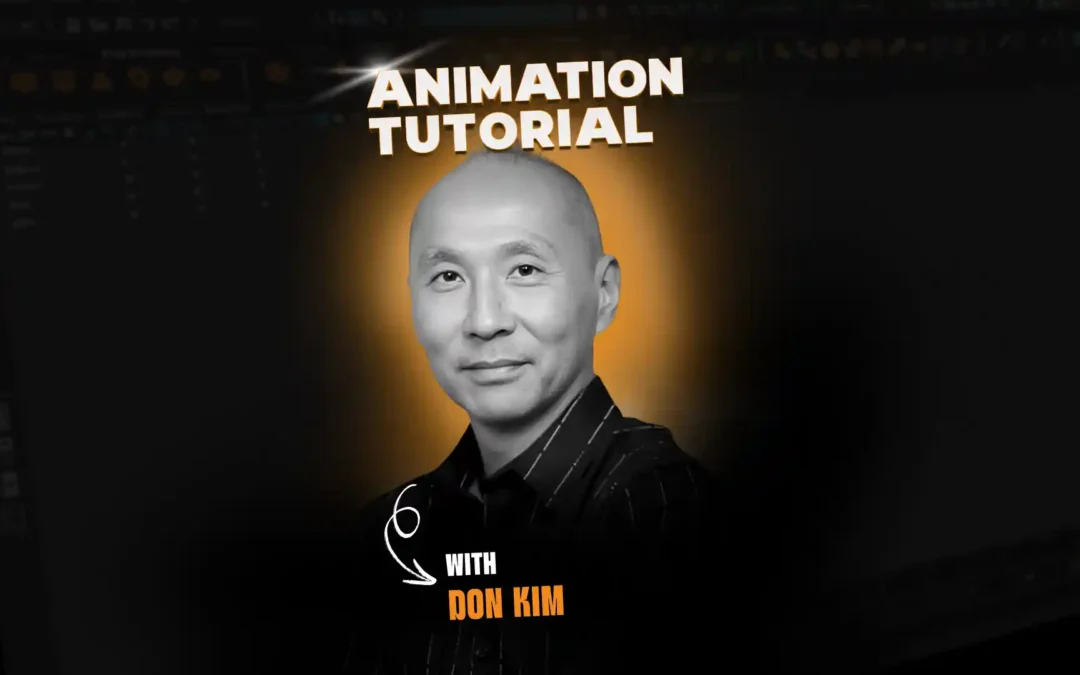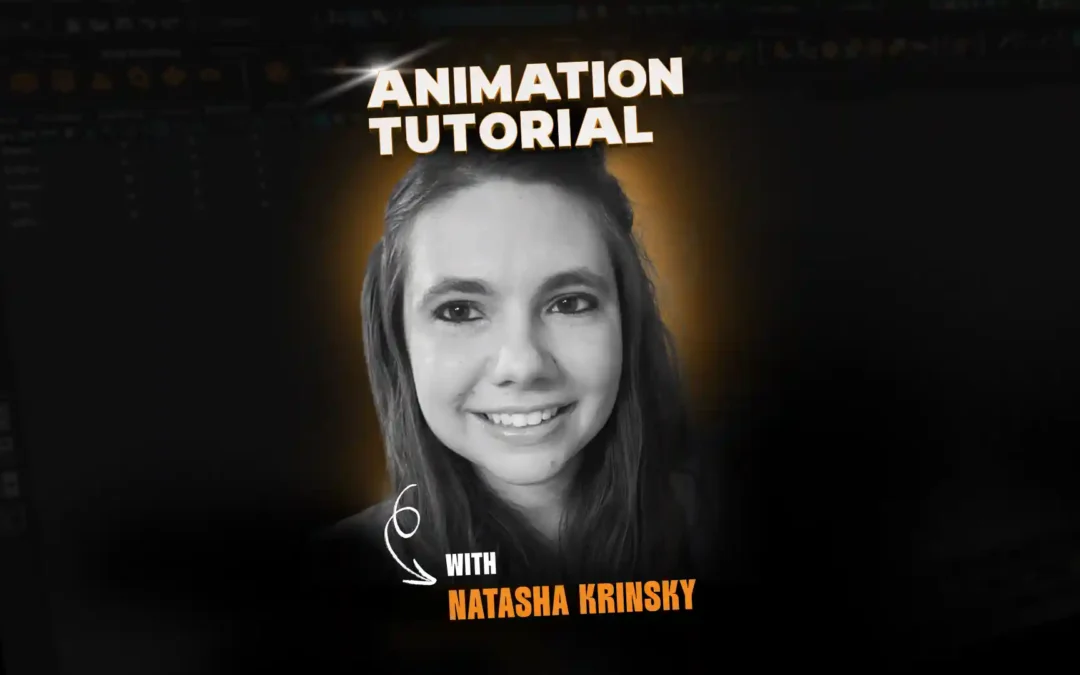DreamWorks’ 2010 animated feature How to Train Your Dragon produced glowing reviews and Oscar nominations for Best Animated Feature Film for directors Dean DeBlois and Chris Sanders. This year, DeBlois, the voice cast, and many of the people on the 2010 crew bring us the eagerly awaited How to Train Your Dragon 2, which is already receiving rave reviews from top critics. It’s five years later in the story, as well. The young Viking Hiccup is now 20 years old and he and his dragon Toothless are now partners, friends, accomplished flyers, and intrepid explorers, which leads them to discover Hiccup’s mother, and encounter unexpected danger. How to Train Your Dragon 2 premiered at the Cannes Film Festival May 16 and is scheduled for US release June 13.
Dane Stogner, a former Animation Mentor student who joined DreamWorks Animation to work on Madagascar: Escape 2 Africa, became an expert on Toothless during the first Dragon film. For Dragon 2, he took charge of the hero dragon as Character Lead Animator for Toothless. We talked with Stogner about his experiences animating the friendly yet dangerous Night Fury.
If you become a character expert, you might spend years animating that character.
“I’ve been working with Toothless for . . . for the better part of my life,” Stogner laughs. “For almost six years now. I worked on Dragon 1, then the short Dragons: Gift of the Night Fury. I was the first animator on Dragon 2. I was brought on for my expertise with Toothless, and I had a working relationship with Simon Otto [Head of Character Animation]. I was on Dragon 2 for two-and-a-half years – until early May.”
Systems might change from one movie to the next.
“Dragon 2 is the first show to use Premo, DreamWorks’ new animation software system,” Stogner says. “So I had to conceptualize how we could work with Toothless in the new system. I spent the first nine months on the show dividing my time evenly between Premo development, Toothless rig and library development, and animation. I worked with the face and body riggers to develop his face and body rig for the new software. Every way we interacted with the character was new.”
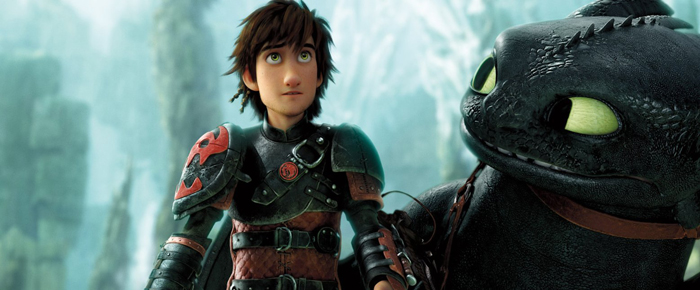
© DreamWorks Animation LLC. All Rights Reserved.
New software can completely change the way animators work.
“We went from using, arguably, one of the most archaic animation software in existence to what I would say is the best in the business,” Stogner says. “It’s a giant leap forward. Premo, the new software, is always live. You can press play and it will play back in realtime with full resolution geometry and a bit of surfacing at any second. There’s no such thing as a playblast. We can adjust curves and poses on the fly, even while it’s playing. It’s unbelievable. I think the developers started from the vantage point of what animators have always wanted and they made it.
“Premo was designed around the idea that animators would have a [Wacom] Cintiq. So, we can just touch and move the character. It is almost like stop motion sometimes. Even on the face. Just push and pull parts of the face around on the surface. We have fully integrated pose libraries, control hierarchies, ghosting, paths, follow cams, and built-in drawing tools with layers like Photoshop. The drawing tools were so easy to use I sometimes did 2D pencil tests in the shot on top of the background rather than shooting reference. It’s exciting.”
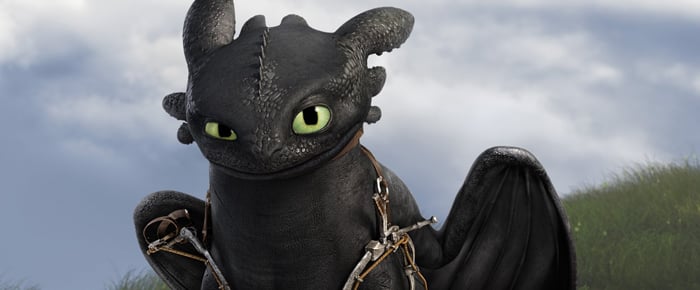
© DreamWorks Animation LLC. All Rights Reserved.
Eyes alone can tell a story.
“Toothless has quite large eyes and square pupils,” Stogner says. “When he’s happiest and most friendly, his pupils are big and that makes him extra cute. Also, in order to make him cute and goofy, we tend to make him slightly cross-eyed. When he’s aggressive and protective of Hiccup, his pupils narrow and his lids close quite a bit. There’s a time in the story where he isn’t totally in control, and we had to make sure it was clear to the audience that it wasn’t his fault and that he wasn’t aware of his actions. We did most of that by keeping his lids wide open, having his pupils narrow more than they ever had, and making him a bit wall-eyed.
Having a small range of expressions doesn’t make it easier to keep a character on model.
“Toothless’s face is a touchy thing,” Stogner says. “It’s easy to take him off model. In fact, most of the toys make him look off model. There are even moments in the first film that the Toothless experts on our animation team agree that by today’s standards, are off model. It’s the angle of his eyelids. The size of his eyes. The orientation of his pupils. The amount his nostrils flare. The way he does or does not pull his lips back to reveal his teeth. The way he poses his ears. A good example is his brows. It’s difficult to give them a classic worry shape because he looks really weird and square and has a ‘skull’ appearance.
When you can’t animate a character’s face to create the emotional performance you want, move his body.
“Because Toothless has a lot of screen time and he’s Hiccup’s companion throughout the film, we needed to give him a wide array of emotions,” Stogner says. “But, animals don’t have the same facial range as humans. So, we interject more behavioral and body language to give him those emotions.”
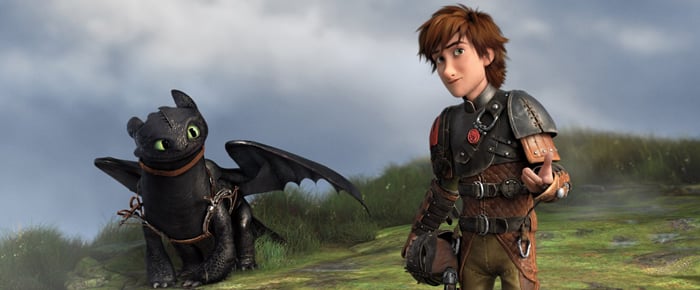
© DreamWorks Animation LLC. All Rights Reserved.
Animals provide good reference, even unlikely animals.
“For the first film, we mostly referenced black panthers, house cats and wombats for Toothless’ body language,” Stogner says. “He was very cat-like and stand-offish and mysterious, a scary creature that Hiccup had to befriend. So cats were appropriate. But, two out of three of us Toothless experts, and even Dean DeBlois himself, are greater fans of dogs than cats, and I think there’s legitimacy in the story for having his personality come across more puppy or dog-like in this film. He’s been living with Hiccup for five years. In addition, my favorite pet was my rabbit Waxwick, so I used any opportunity I could to throw in a little rabbit flavor. I’ll definitely try to add more in the next film. There’s a little behavior rabbits do that rabbit fans call binkying where they hop in circles. It’s really cute. They look a little like they’re having a seizure, but they are just happy.
Sometimes there’s no animal to imitate.
One of the shots I did early on was of Toothless walking around on his hind feet like a biped with Hiccup dangling from his neck. He has a bit of a funny walk. We saw a hint of that in the first film in the ‘Forbidden Friendship’ sequence. In this film, we see him full frame walking to the edge of a cliff with his legs straight in this goofy, goose-step walk. It’s one of his most surprising moments.”
Study flight before performing a flying creature.
“We had this thing called flight school on the first film, and we repeated it for the second for anyone who needed or wanted it,” Stogner says. “Simon Otto developed a complete curriculum. What flaps actually do. Everything to consider. That’s how everyone became able to make flights somewhat believable. And then it just took a lot of practice. On the first film, we were praised for our flying shots. We cared a lot about making the flying as believable as possible, and Simon was a real stickler. We learned from the first experience and from how specific Simon was about it. I hope we can get the same praise for this one. In this film Toothless is on the ground a lot because Hiccup is grounded a lot, but we have some spectacular flying sequences. Memorable ones.”
Remember that dragons are heavy.
“If I’m going to get serious about it, these dragons weigh at least a ton,” Stogner says. “They have to have weight when they fly. For reference, we watched videos of owls, hawks, and eagles, and since dragons don’t exist, we looked at a lot of good and bad examples of animated dragons. We saw so many example of really beautifully modeled and surfaced and lit dragons that looked amazing, but . . . Just this weekend, I saw an incredible render of a dragon in a TV show that was hovering weightless, flapping its wings. There was no drag of his legs or drop in the body.”
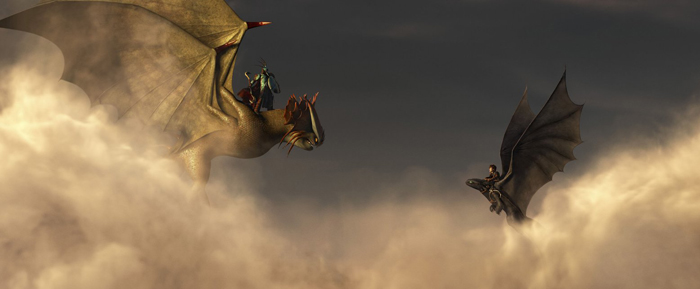
© DreamWorks Animation LLC. All Rights Reserved.
A correct wing pose helps animators create believable flight.
“We made sure Toothless’s wings had an airfoil shape to them, curved on the top and flat on the bottom like airplane wings,” Stogner says. “That’s also reflected in nature. It primarily produces the lift in flight. And, it also looks better. It goes a long way toward making it physically believable.”
Air is not static.
“Air is a physical medium with varying pressure and wind speeds,” Stogner says. “If you have a dragon too still, it doesn’t look right. You want to feel the turbulences and those fingers on the wings rustling. You want to make little adjustments to keep him stable – dips, drops, rises in the body – to make him feel like he’s moving through something as chaotic as air.”
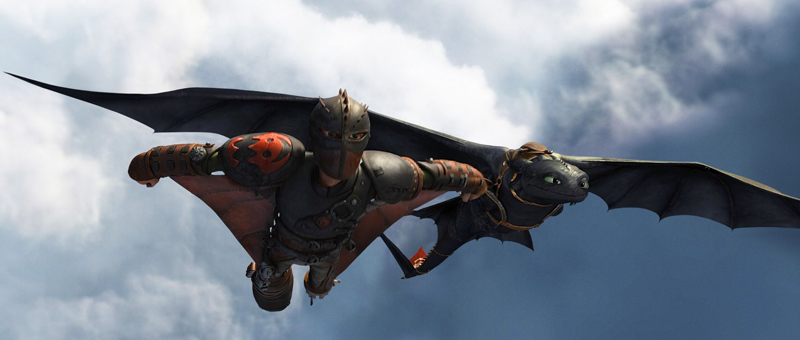
© DreamWorks Animation LLC. All Rights Reserved.
Wing “fingers” matter, so the more macro controls, the better.
“We had macro controls on the first film so that with one animation curve I could bend all of Toothless’s wing fingers at the base, or splay or curl them,” Stogner says. “This time around, I wanted inner, outer, and tip curls, bends and splays. We had three times more macro controls on this film. I don’t know how many other animators used them, but I did in every shot. Each wing has eight fingers and each finger has five joints. They are like enormous long hands with extra fingers. I could move each one of the dozens and dozens of finger joints individually, but it was easier and faster to manipulate the motion with a handful of macro controls.”
And when animators can work faster, Toothless can fly better.
“Other than creating more macro controls and refining the wing rig behavior, we didn’t develop or learn anything new in how to make flight believable,” Stogner says. “But, the speed of Premo allowed us to make it look better. We had more time for details because we didn’t have to wait for recalculation of frames every time we adjusted a flutter. We could adjust every flutter and watch it play back instantly. I would have liked for him to have been in the air even more.”
You never know who or what might affect a performance.
“Hiccup’s mother reveals new secrets that even Toothless himself didn’t know,” Stogner says. “His spikes split in two and he can open and close them for aerial maneuvers. He also has new physical capabilities. Hiccup designed a new saddle for him that has new functionality and rules for how it affects him and his flight.”
“There were also some tiny model changes that only super fans noticed. He has nubs on his jaw. Those were just extra details we added for this film. But, the fans hypothesized that perhaps the nubs were a sign, much like Hiccup’s chin stubble, that Toothless had aged. There’s a shot where Hiccup’s mother says, ‘Look, he’s your age.’ James Baxter, a supervising animator on the show had seen the super fans’ theories. So he made the choice to have her point to the nubs. The fans influenced the movie.”
Barbara Robertson is an award-winning journalist living in the Bay Area.
Learn more about former Animation Mentor student, Dane Stogner.
Learn how to animate dragons in the 12-week workshop, Creature Animation: Fight or Flight.
